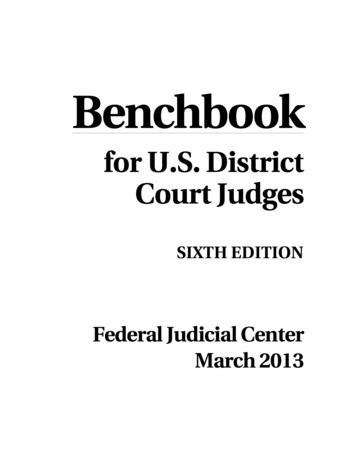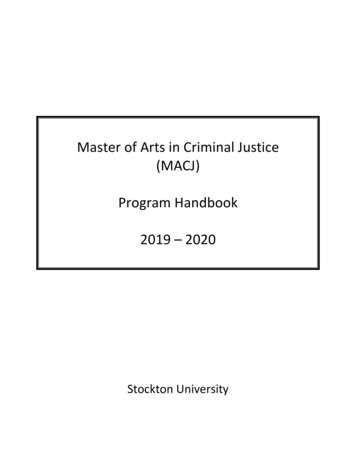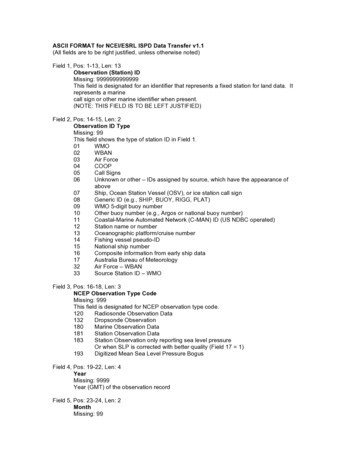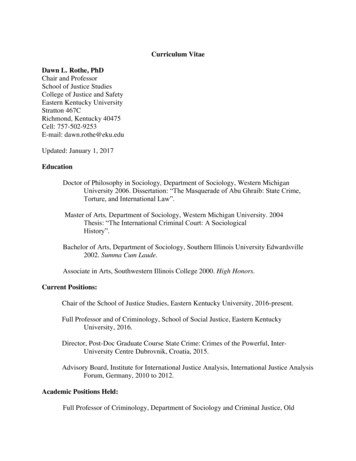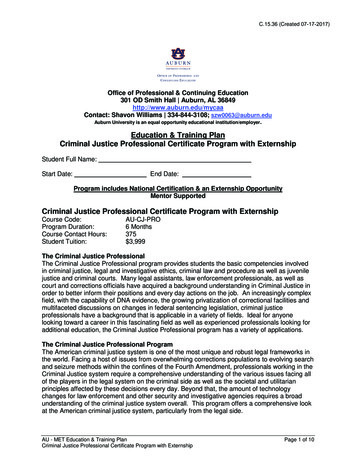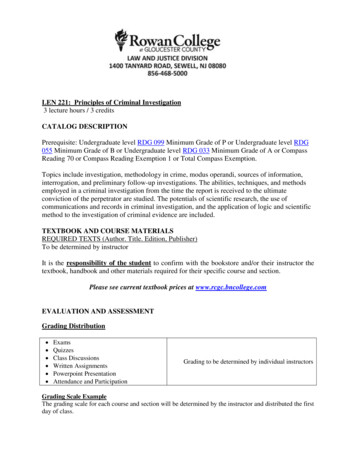
Transcription
1LEN 221: Principles of Criminal Investigation3 lecture hours / 3 creditsCATALOG DESCRIPTIONPrerequisite: Undergraduate level RDG 099 Minimum Grade of P or Undergraduate level RDG055 Minimum Grade of B or Undergraduate level RDG 033 Minimum Grade of A or CompassReading 70 or Compass Reading Exemption 1 or Total Compass Exemption.Topics include investigation, methodology in crime, modus operandi, sources of information,interrogation, and preliminary follow-up investigations. The abilities, techniques, and methodsemployed in a criminal investigation from the time the report is received to the ultimateconviction of the perpetrator are studied. The potentials of scientific research, the use ofcommunications and records in criminal investigation, and the application of logic and scientificmethod to the investigation of criminal evidence are included.TEXTBOOK AND COURSE MATERIALSREQUIRED TEXTS (Author. Title. Edition, Publisher)To be determined by instructorIt is the responsibility of the student to confirm with the bookstore and/or their instructor thetextbook, handbook and other materials required for their specific course and section.Please see current textbook prices at www.rcgc.bncollege.comEVALUATION AND ASSESSMENTGrading Distribution ExamsQuizzesClass DiscussionsWritten AssignmentsPowerpoint PresentationAttendance and ParticipationGrading to be determined by individual instructorsGrading Scale ExampleThe grading scale for each course and section will be determined by the instructor and distributed the firstday of class.
2ROWAN COLLEGE AT GLOUCESTER COUNTY CORE COMPETENCIES(Based on the NJCC General Education Foundation - August 15, 2007; Revised 2011)This comprehensive list reflects the core competencies that are essential for all RCGC graduates;however, each program varies regarding competencies required for a specific degree. Critical thinking isembedded in all courses, while teamwork and personal skills are embedded in many courses.RCGC Core Competencies1Written and Oral CommunicationStudents will communicate effectively in both speech and writing.2Quantitative Knowledge and SkillsStudents will use appropriate mathematical and statistical concepts and operations to interpret data and tosolve problems.3Scientific Knowledge and ReasoningStudents will use the scientific method of inquiry, through the acquisition of scientific knowledge.4Technological CompetencyStudents will use computer systems or other appropriate forms of technology to achieve educational andpersonal goals.5Society and Human BehaviorStudents will use social science theories and concepts to analyze human behavior and social and politicalinstitutions and to act as responsible citizens.6Humanistic PerspectiveStudents will analyze works in the fields of art, history, music, or theater; literature; philosophy and/orreligious studies; and/or will gain competence in the use of a foreign language7Historical PerspectiveStudents will understand historical events and movements in World, Western, non-Western or Americansocieties and assess their subsequent significance.8Global and Cultural AwarenessStudents will understand the importance of a global perspective and culturally diverse peoples.9Ethical Reasoning and ActionStudents will understand ethical issues and situations.10Information LiteracyStudents will address an information need by locating, evaluating, and effectively using informationCRJ101 CORE COMPETENCIESThis course focuses on three of RCGC’s core competencies. They are: Oral & Written communication Technological Competency Information LiteracyFALL 2014
3STUDENT LEARNING OUTCOMES:LEN 221 (Principles of Criminal Investigation), students will beable to:1. Explain the historical roots of Criminal Investigation inpolicing. Highlight the first major federal investigative agencies andtheir responsibilities. Explain the Supreme Court’s “due process revolution” and itsimpact on policing. Discuss Bertillon’s method of anthropometry. Summarize the historical development of fingerprintidentification. Explain the concept and practice of DNA typing. Outline the milestones in the development of firearmsidentification. Outline the intelligence/analytical cycle. Understand various components of crime analysis. Assess criminal profiling and its criticisms. Discuss the organized/disorganized offender model. Explain the practice of investigative psychology. Describe behavioral evidence analysis. Discuss the practice of geo-profiling. Recognize financial difficulty indicators used in financialanalysis. Identify three major components of NCAVC and the servicesthey provide. Describe the functions of NCIC and CODIS. Distinguish among detention, arrest, and charging. Explain the benefit of a police officer’s making an arrestunder the authority of a warrant. Define and describe probable cause. Discuss the risk factors involved in making a premature arrest. Briefly outline the steps in a trial process. Assess the importance of a criminal investigator’s knowingthe rules of evidence. Describe the hearsay rule and the philosophy under which theexceptions to this rule have evolved. Explain the reason for the existence of evidentiary privileges. Discuss the role of an investigator as a witness in a criminaltrial. Explain the purpose of cross-examination.RCGC’s CoreCompetenciesOral & essay. Analysisand discussions.Classparticipation.Quizzes / Tests
42. Explain the Investigator’s role and the criminal investigativeprocess. Understand the role of the investigator and the skills andqualities he or she must possess Discuss the major events in the investigation of a crime. Discuss the major steps in a preliminary investigation Define a crime scene. Outline the purposes and functions of a crime sceneinvestigation. Explain the “rules” for the crime scene investigator. Identify potential threats to investigators health and safety. Describe the five major considerations that dominate thecrime scene search. Understand the differences and similarities betweeninterviews and interrogations. Outline the steps in preparing for an interview and aninterrogation. Assess the challenges in relying on eyewitness identification. Explain the role of hypnosis in criminal investigation. Describe Neuro-Linguistic Programming. Identify interviewing processes and techniques. Explain the impact of Miranda v. Arizona and other landmarkSupreme Court cases on police interrogation. Identify interrogation processes and techniques Understand the methods and importance of documenting aninterview and interrogation. Explain the importance of listening during an interview andinterrogation. Understand the importance of field notes. Distinguish between basic and primary investigativequestions. List the six primary investigative questions. Understand formats for basic incident reports. Discuss aids to information gathering. Summarize the report approval and disposition process. List the elements common to incident reports. Summarize the factors used to determine whether a follow-upinvestigation is needed. Outline common internal and external sources of caseinformation. Explain the techniques used in neighborhood and vehiclecanvasses. Discuss the role and use of informants. Understand the purpose and objectives of surveillance. Be familiar with the practice of polygraph and psychologicalstress evaluators. Describe the methods for conducting photo and live line-ups. Explain the guidelines for recording identification results.Oral & Written Take-homeCommunication essay / classparticipation.Quizzes /Tests
53. Explain the importance of physical evidence to the criminalinvestigation process. Distinguish between class and individual characteristics. Outline procedures for locating and handling soil and pollenevidence. Understand process for preserving footwear and tire prints andimpressions. Summarize techniques for collecting glass and paint evidence. Discuss methods of collecting and storing fibers, clothfragments, and impressions. Understand how to locate, identify, and use tools to obtainfingerprints. Describe the importance of forensic dentistry. Discuss the identification and analysis of bloodstains. Identify the determinations that can be made from firearmevidence. Outline techniques for identifying questioned documents. Define and distinguish forensic science and criminalistics. Understand the importance of an investigator’s understandingof crime laboratory capabilities. Describe the three measures of effectiveness of crimelaboratories. Distinguish the Frye test from the Daubert test regarding theadmissibility of scientific evidence. Explain the role and importance of DNA analysis in criminalinvestigation. Identify the latest technologies in DNA evidence investigationand data banking. Highlight the process of fingerprint identification andcomparison. Describe AFIS and IAFIS. Describe NIBIN. Briefly explain the techniques and methods used by both theATF and FBI crime laboratories to examine evidence.4. Explain why the investigation of felonious injuries and criminalhomicides can be the most important, yet difficult, responsibilityassigned to a police investigator. Describe the four motivational models for classification ofhomicide. Identify the investigator’s responsibilities when responding tothe scene of a suspected homicide or assault. Comprehend the importance of personal identification of avictim in a homicide investigation. Outline the major elements in a search for buried bodies.Oral & Written Take-homeCommunication essay.Quizzes /TestsOral & Written Take-homeCommunication essayAnalysis andclass/ studentparticipation
6 Understand the individual observations used collectively todetermine the time of death.Discuss the five most common types of wounds encounteredin injury and death investigations.Assess information used by investigators to distinguishbetween a homicide and a suicide.Outline facts that need to be determined in the investigation offire deaths.Define stalking, and identify common categories of stalking.Describe what items are needed for a psychological profile.Explain the hierarchical structure of policing.List and explain the classification of sex offenses.List and explain the four types of sexual murder.Discuss interview procedures and investigative questions forsexual assault cases.Explain why women do not report rape to the police and themotivations for false rape allegations.Discuss the importance of trace evidence.Assess investigative and evidence collection techniques fordrug-facilitated sexual assaults.Recognize common characteristics of sexual asphyxia, orautoerotic death.Describe a psychological autopsy.Recognize types and patterns of injuries in child abuse andrelated crimes.Discuss sex-offender registration and community notificationlaws.Recognize threat assessment factors and levels of risk incommitting school crime.Identify and explain the elements and styles of robberyincluding police response and investigative strategies.Discuss three explanations for the increase in car-jacking.Describe action, physical, and situational stereotyping.Identify types of evidence to be collected in safe burglaries.Outline strategies for investigating criminal fences and otherstolen-property outlets.Understand the process of cellular-phone cloning.Describe the classifications of shoplifters and the patterns ofprofessional shoplifting groups.Explain the most common types of confidence games.Outline various techniques for laundering money.Describe identity theft, credit card fraud, check fraud, andmail fraud.Discuss the looting of archaeological sites.Identify types of motor vehicle theft.Be familiar with techniques for disposing of stolen motorvehicles.Describe challenges associated with the theft investigationheavy equipment and farm equipment.
7 Identify major investigative resources.Discuss methods for assisting in the identification of arecovered vehicle.List and explain several vehicle theft fraud indicators.Describe vehicle fire investigation methods,Explain vehicle and equipment theft prevention approaches.Assess title and registration issues related to marine theft.Discuss aircraft and avionics theft and relevant identificationand investigative techniques.Outline the types of crimes in which the computer is the targetto include investigation and prevention.Discuss computers as an instrumentality of the crime.Understand the tools that computer criminals use to commitcrime.Discuss debates regarding privacy issues concerning theregulation of the Internet.Discuss the prevalence of timber theft.Explain agrichemical theft.Summarize measures to prevent rural and agricultural crimes.Distinguish between situational and professional poachers.Understand investigative techniques used in wildlife crimes.List and describe the characteristics of hazardous waste.Discuss methods of investigating environmental crimes.Discuss the steps and methods in the preliminary investigationof arson.Explain the two types of explosions.Outline the procedures for handling and investigating bombthreats.Outline techniques used in investigating dangerous drugs andnarcotics.Assess the motives, methods, and management of druginformants.Describe the process of identifying and conducting raids onclandestine labs.Explain the type of information necessary to establishprobable cause and obtain search warrants.Communicate information orally in a logical and e-homeessayTestsPosition papersOralpresentationPower pointpresentation.Analysis andstudentparticipation
homicide. Identify the investigator's responsibilities when responding to the scene of a suspected homicide or assault. Comprehend the importance of personal identification of a victim in a homicide investigation. Outline the major elements in a search for buried bodies. Oral & Written Communication Take-home essay Analysis and


